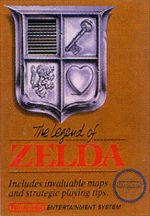The Legend of Zelda

| |
| The Legend of Zelda | |
| Full Title | The Legend of Zelda |
| Developer | Nintendo |
| Publisher | Nintendo |
| System | NES, Game Boy Advance, Virtual Console (Wii, 3DS, Wii U) |
| Release Date | NES JP February 21, 1986 US August 22, 1987 EU November 15, 1987 Game Boy Advance JP February 14, 2004 US June 2, 2004 EU July 9, 2004 Wii Virtual Console US November 19, 2006 JP December 2, 2006 EU December 8, 2006 3DS Virtual Console JP December 22, 2011 EU April 12, 2012 US July 5, 2012 Wii U Virtual Console JP August 28, 2013 US/EU August 29, 2013 |
| Genre | Adventure |
| Gallery | GH Gallery |
| Rating | ESRB: E |
The Legend of Zelda (Known in Japan as The Hyrule Fantasy: Zelda no Denetsu) is the 1986 adventure game for the NES that began the long-running Legend of Zelda series. It is the brainchild of Shigeru Miyamoto, who envisioned the game as a "miniature garden you can put in a drawer" with an emphasis on exploration and being non-linear at the same time that Super Mario Bros. was made to be the more linear Nintendo title.
Story
The evil Ganon has stolen the Triforce of Power and seeks the Triforce of Wisdom which is held by Princess Zelda. However, Zelda is able to protect the Triforce by breaking it into eight shards. These Triforce shards are subsequently hidden within the eight dungeons of the Underworld by Impa, Zelda's caretaker. After a young traveller named Link saves her from a group of Ganon's monsters, she convinces him to unite the Triforce of Wisdom in order to save Hyrule. Link eventually finds all seven shards and destroys Ganon, gaining his Triforce of Power while freeing Princess Zelda.
Information
The Legend of Zelda was one of the first games with game-saving capability that did not require passwords. In the game the player controlled Link in his exploration of Hyrule. Link also finds a variety of items that he can use to unlock new areas. The game contains nine dungeons, which do not necessarily have to be beaten in the suggested order (except for the final dungeon, which can only be unlocked by beating the first eight). Just as in Super Mario Bros., beating the game would unlock a new "second quest" (it could also be unlocked by entering "Zelda" as the player's name). The second quest was identical to the original except that the entrances to the dungeons were all changed, and the interiors of each dungeon were completely redesigned to pose more challenge.
Continuity Notes
- Within Zelda chronology, The Legend of Zelda is set in the hypothetical third timeline split that follows a version of Ocarina of Time in which Link fails to defeat Ganon. This game follows A Link to the Past and is followed by Zelda II: The Adventure of Link. That makes The Legend of Zelda the second-to-last game in this timeline and marks the seemingly final defeat of Ganon for this branch.
- This game plants the roots of some concepts that will be explored in depth in later games, such as the Triforce (of which only Power and Wisdom appear) and the establishment of the first recurring character, Impa.
Legacy
This game acted as the foundation of the Zelda series and has been known as an influence for many adventure games over the years. The original Legend of Zelda has also been sampled in other games such as some of the WarioWare games as well as NES Remix and Ultimate NES Remix.
Sequels
The Legend of Zelda was followed by Zelda II: The Adventure of Link, which followed a very different gameplay style that was a mix of side-scrolling and RPG. However, starting in The Legend of Zelda: A Link to the Past, the Zelda series returned to the gameplay style of the original NES game.
Ports and Remakes
- At one point Capcom was developing a remake of The Legend of Zelda for the Game Boy Color. It was cancelled, but some elements of the original game (such as several of the game's bosses) were included in Oracle of Seasons and Oracle of Ages.
- The Legend of Zelda was included as an unlockable game in 2001's Animal Crossing, but it is so far unknown how to unlock it without the use of cheating devices.
- In November 2003, The Legend of Zelda was included in The Legend of Zelda Collector's Edition, a promotional disc for the Nintendo Gamecube.
- The Legend of Zelda was ported to the Game Boy Advance in 2004 as part of the Classic NES Series and was released on the Wii's Virtual Console in 2006. A demo version of the Virtual Console game was included in Super Smash Bros. Brawl as a Masterpiece.
- In December 2011, The Legend of Zelda was made available for regular download on the 3DS's eShop as part of the 3DS Virtual Console in Japan, and it was released for other regions in 2012. It was available for an earlier, free download for participants in the 3DS's Ambassador Program on August 31, 2011 as part of a set of ten NES games.
- In August 2013, it was released for download on the Wii U as part of the Wii U Virtual Console.
- In 2016, it was among the games included in the NES Classic Edition.
Other
In 1989, a cartoon series loosely based on this game was aired with the Super Mario Bros. Super Show, but it was canceled after only thirteen episodes.
See Also